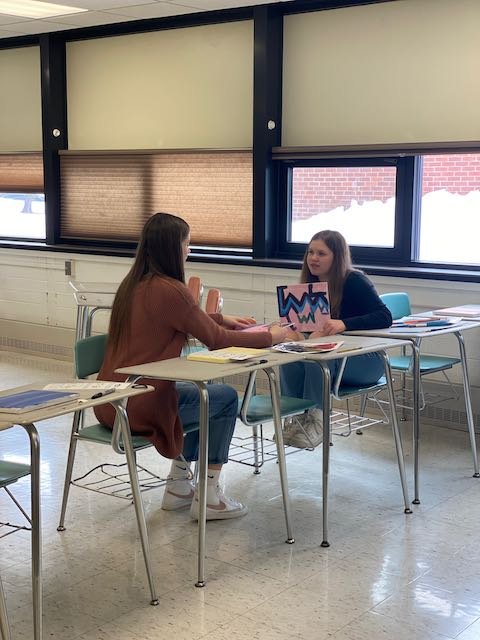Teaching Art & Innovation
Teaching Artist Bio:
Heidi Jeub is a teaching artist with over two decades of experience, specializing in bookbinding, visual journaling, and abstract painting. Since 2003, she has shared her passion for art with students of all ages, drawing on her own experience as an “alternative learner” to create engaging, interdisciplinary lessons that connect art to subjects like literature, science, math, and technology.
Heidi integrates STEM concepts into her art-making, believing that artists are pioneers in pushing technology to realize their creative visions. She has designed innovative projects that blend art with manufacturing, science, and math, helping students develop collaboration skills and 21st-century problem-solving abilities. Her versatility in adapting to diverse educational environments allows her to connect with learners from all backgrounds, fostering creativity across disciplines.
Teaching Philosophy and Approach
Heidi Jeub is a passionate advocate for artist residencies that have a lasting, community-driven impact. She believes residencies should reflect both the artist’s background and the unique identity of the community they enter. Rather than being a one-way exchange of talent, Heidi views residencies as a two-way exchange of ideas, skills, and experiences that extend beyond the classroom.
Heidi is committed to maximizing the potential of residencies through creative funding and strategic partnerships, ensuring their impact reaches beyond the educational setting. By leveraging local resources and social media, she works to integrate the artist’s work into the broader community, creating a ripple effect that benefits both students and the wider population.
A strong believer in the power of artistic freedom, Heidi sees residencies as an opportunity for students to explore creativity without the pressure of grades or peer judgment. This freedom fosters innovation, self-expression, and confidence. With a focus on community sustainability, Heidi strives to create residencies that leave a lasting cultural legacy.




























Current Residency Offerings
Art + STEM Fusion 🔬🎨
This residency explores the intersection of art and STEM by examining art forms that have historically engaged with new technologies or have influenced modern technological advancements through creative experimentation. Each residency is customized to align with the specific goals of the classroom or age group, allowing for seamless integration of science, technology, engineering, and math concepts with creative expression. Students will explore how art can inspire innovation and how experimentation in the arts can lead to breakthroughs in technology and design.
Heidi’s work connects the arts to STEM concepts, so showcasing how she integrates these subjects will be captivating for both art enthusiasts and those interested in education or STEM.
Interdisciplinary Art Projects 🌍📚
Build lifelong skills through interdisciplinary projects that merge art with literature, science, and beyond. In these collaborations, students will work with diverse classes or unexpected partners to create meaningful art projects that emphasize the value of cross-collaboration, communication, design thinking, and needs analysis. Projects may include murals, metal or wood sculptures, photography, and more, with a focus on how art can strengthen connections between different fields and inspire innovative solutions.
Visual Journaling for Personal Growth ✍️📖
Visual journaling offers a unique approach to using journaling as both a creative outlet and a reflective practice. This class guides students through the process of creating personal visual journals that combine art, writing, and self-reflection. Participants will learn how to use different media—such as drawing, painting, collage, and photography—to express thoughts, explore emotions, and document experiences in a visually rich format. The class emphasizes the therapeutic benefits of journaling, encouraging students to use their journals as a safe space for experimentation, self-expression, and mindfulness.
Through a series of guided exercises, students will discover how to merge visual storytelling with written reflections, explore themes of identity, growth, and emotional processing, and develop their unique journaling style. Whether for personal growth, artistic exploration, or academic purposes, visual journaling serves as a powerful tool for creative expression and introspection.
Abstract Painting + Science 🎨🔬
In this class, students will explore the fascinating intersection of abstract painting and scientific principles. Heidi will guide participants in understanding how abstract art can serve as a visual representation of complex scientific concepts. Through hands-on painting exercises and discussions, students will learn how to translate ideas from chemistry, physics, and biology into dynamic abstract works of art.
Bookbinding as a Life Skill 📚🖋️
Bookbinding is a creative and practical skill that helps students develop organization, focus, and craftsmanship. In this class, participants will learn how to create their own books while exploring how bookbinding can be used to organize thoughts, collect images, and capture ideas. As Heidi Jeub, teaching artist, shares: “Bookbinding helped me learn as a student and through my college career. It helped me organize my thoughts, gather images, and capture quotes.”
Beyond creativity, bookbinding teaches valuable life skills like attention to detail, patience, and problem-solving. Students will walk away with a completed book, as well as a deeper understanding of how design and structure work together to create something meaningful. This hands-on craft can be used for journals, sketchbooks, and more, offering both practical benefits and personal expression.
Minnesota based bookings of Artist in Residence programs can be directed to COMPAS— LINK

